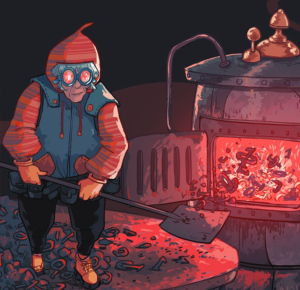Natalie Wolchover in Quanta:
 In his 1824 book, Reflections on the Motive Power of Fire, the 28-year-old French engineer Sadi Carnot worked out a formula for how efficiently steam engines can convert heat — now known to be a random, diffuse kind of energy — into work, an orderly kind of energy that might push a piston or turn a wheel. To Carnot’s surprise, he discovered that a perfect engine’s efficiency depends only on the difference in temperature between the engine’s heat source (typically a fire) and its heat sink (typically the outside air). Work is a byproduct, Carnot realized, of heat naturally passing to a colder body from a warmer one.
In his 1824 book, Reflections on the Motive Power of Fire, the 28-year-old French engineer Sadi Carnot worked out a formula for how efficiently steam engines can convert heat — now known to be a random, diffuse kind of energy — into work, an orderly kind of energy that might push a piston or turn a wheel. To Carnot’s surprise, he discovered that a perfect engine’s efficiency depends only on the difference in temperature between the engine’s heat source (typically a fire) and its heat sink (typically the outside air). Work is a byproduct, Carnot realized, of heat naturally passing to a colder body from a warmer one.
Carnot died of cholera eight years later, before he could see his efficiency formula develop over the 19th century into the theory of thermodynamics: a set of universal laws dictating the interplay among temperature, heat, work, energy and entropy — a measure of energy’s incessant spreading from more- to less-energetic bodies. The laws of thermodynamics apply not only to steam engines but also to everything else: the sun, black holes, living beings and the entire universe. The theory is so simple and general that Albert Einstein deemed it likely to “never be overthrown.”
Yet since the beginning, thermodynamics has held a singularly strange status among the theories of nature.
“If physical theories were people, thermodynamics would be the village witch,” the physicist Lídia del Rio and co-authors wrote last year in Journal of Physics A. “The other theories find her somewhat odd, somehow different in nature from the rest, yet everyone comes to her for advice, and no one dares to contradict her.”
Unlike, say, the Standard Model of particle physics, which tries to get at what exists, the laws of thermodynamics only say what can and can’t be done. But one of the strangest things about the theory is that these rules seem subjective. A gas made of particles that in aggregate all appear to be the same temperature — and therefore unable to do work — might, upon closer inspection, have microscopic temperature differences that could be exploited after all. As the 19th-century physicist James Clerk Maxwell put it, “The idea of dissipation of energy depends on the extent of our knowledge.”
In recent years, a revolutionary understanding of thermodynamics has emerged that explains this subjectivity using quantum information theory — “a toddler among physical theories,” as del Rio and co-authors put it, that describes the spread of information through quantum systems.
More here. [Thanks to Sean Carroll.]
Helen Lewis at The New Statesman:
